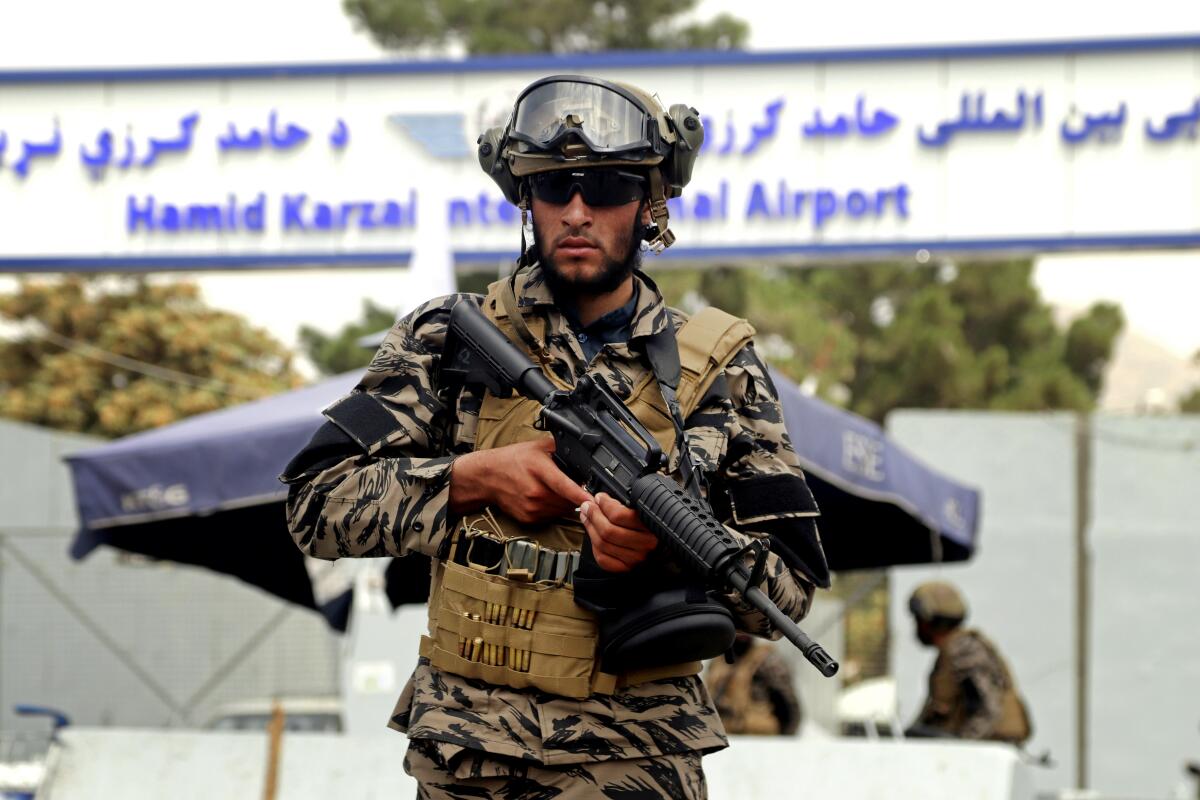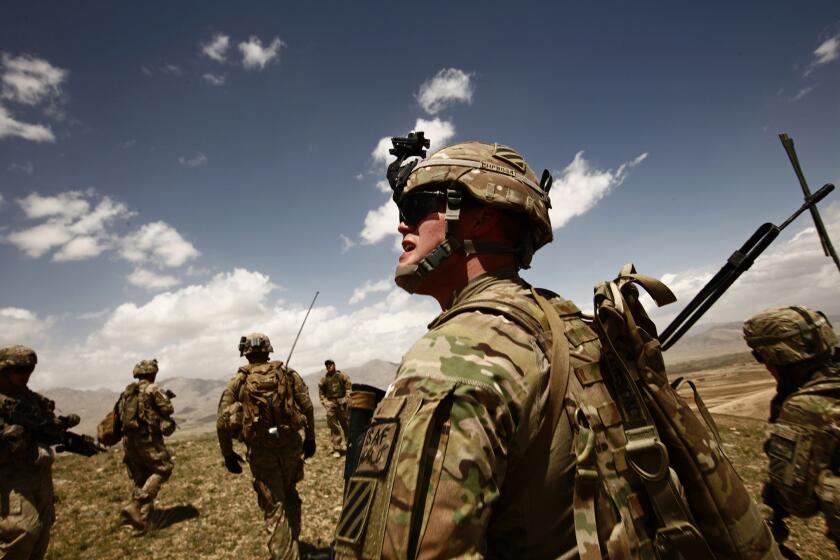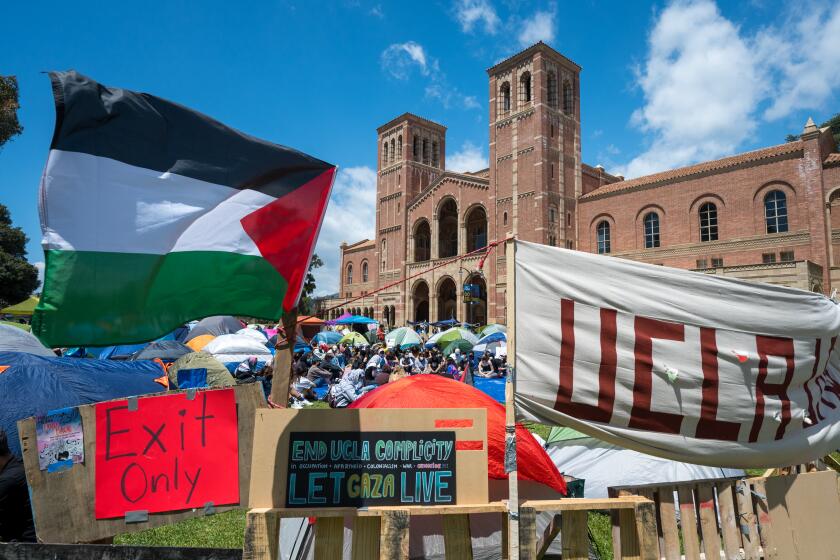What 9/11 may have taught the U.S.: How to avoid being drawn into another unwinnable war

- Share via
The last two decades have taught us that a retaliatory invasion may assuage foreign policy hawks or hard-liners, but without a clear strategy and well-defined objectives, a hasty and ill-conceived response can end up causing more harm than the initial attack. The U.S. spent trillions of dollars and lost thousands of lives waging war in Afghanistan, and now the country has reverted to its pre-9/11 status, with the Taliban back in power and Al Qaeda poised for a comeback.
By attacking the United States 20 years ago Sept. 11 and brutally murdering nearly 3,000 people, Al Qaeda leader Osama bin Laden was trying to lure the U.S. military into war in Afghanistan and drain the United States of blood and treasure. Of course, he spectacularly succeeded.
According to the Costs of War project at Brown University, what the U.S. once called the “global war on terrorism” has cost the country $6.4 trillion — and the lives of more than 7,000 U.S. service members.
The United States played directly into the hands of Bin Laden and his jihadist army when it invaded Afghanistan — where Al Qaeda is headquartered — little more than a month after the 9/11 attacks. Instead of a “war on terrorism,” the “war” should have been a narrowly scoped counter-terrorism campaign with a specific target: Al Qaeda.
Without a clear strategy — and relegated to second-tier status after the 2003 U.S. invasion of Iraq — the mission in Afghanistan meandered. What should have been a war to destroy Al Qaeda became an effort to rebuild a war-torn nation.
Now the U.S. has finally left Afghanistan but without accomplishing its mission of destroying Al Qaeda, which is expected to metastasize after the withdrawal. After so many years of a grinding stalemate with no clear path out of the morass, President Biden vowed to withdraw all U.S. troops from Afghanistan by the end of August and kept his word.
If jihadists or other terrorist groups manage to successfully mount another major attack on U.S. soil, will the United States be able to avoid being drawn into another unwinnable war? If it cannot, an attack planned from a country with a sizable presence of jihadists — such as Yemen, Somalia or Libya — could trigger a full-scale U.S. intervention, leading to another vicious cycle of occupation, nation-building and isolated successes that never result in strategic victory.
A successful approach to statecraft involves identifying, managing and responding to threats as they emerge. It is about knowing when to use force, and when to show restraint. If the U.S. suffers another devastating terrorist attack, a transparent and nationwide discussion — that includes Congress and other critical government institutions — must occur regarding what the proper response should be.
At the crux of this conversation is whether the U.S. should even have invaded Afghanistan, a question that has taken on added importance, given the outcome of the America’s longest war. After the 9/11 attacks, Al Qaeda was given sanctuary by the Afghan Taliban, a militant Islamist group that refused to hand over Bin Laden to the United States. To bring Bin Laden and other Al Qaeda senior leaders to justice, President George W. Bush was persuaded to take action.
U.S. troops fought in Afghanistan longer than in any other war. Here’s a look at major events over the last two decades.
On Oct. 7, 2001, Bush announced the U.S. military would target “Al Qaeda terrorist training camps and military installations of the Taliban regime in Afghanistan.” Within weeks, the camps were destroyed and the Taliban had been thoroughly routed on the battlefield. The Bush administration refused to consider including the Taliban in a postwar power-sharing agreement with the Afghan government and other power brokers, ushering in the next phase of the war, which included a U.S. and allied military occupation of Afghanistan, exactly what Bin Laden had wanted.
Bin Laden spoke frequently about his plan to bleed the United States until the point of bankruptcy, as he believed the mujahedin — Muslim fighters who considered themselves “holy warriors”— had done to the Soviets in the lead-up to the end of the Cold War. Afghanistan has long been known as the “graveyard of empires,” a land of battle-hardened tribal warriors and unforgiving terrain. Even with the most advanced military in modern times, the U.S., the North Atlantic Treaty Organization and allied troops were unable to defeat the Taliban.
Rampant corruption across successive Afghan governments virtually ensured the spread of Taliban “shadow governors,” highlighting the political aspect of the conflict, something the U.S. repeatedly failed to comprehend. The U.S. military could destroy any target, but as mission creep set in, navigating complex tribal relations became part of a soldier’s job description. Militarily, a cross-border haven in Pakistan meant that the Taliban always had a sanctuary where fighters could rest, recuperate and rearm.
One of the most important lessons from the “global war on terrorism” is that the United States should be modest about what it can achieve with military force alone. Even the world’s most powerful military failed in its war to defeat the Taliban and stabilize Afghanistan. Addressing the challenges of failed states and violent extremism also requires diplomacy, international development and education for the marginalized populations, including women and children.
And yet, the hard power of military threat will continue to be a necessary component of U.S. foreign policy; the threat posed by jihadists remains potent. Given the magnitude of the 9/11 attacks and the psychological impact on the country, the United States had no choice but to respond. But it did so on Al Qaeda’s terms, not America’s.
Jihadists seized upon the U.S. invasion of Afghanistan and then Iraq in 2003 as proof that Bin Laden was right all along — the U.S. was at war with Islam. Several high-profile incidents — including the torture of captured Al Qaeda suspects, the prison for detainees at Guantanamo Bay and the scandal at Abu Ghraib prison in Iraq where Muslim prisoners were ritually degraded, abused and humiliated — sullied American soft power, the ability to lead by example.
Twenty years after the launch of the global U.S. counter-terrorism campaign, there are nearly four times as many jihadists as there were on Sept. 11, 2001. More than 230,000 of these fighters are spread across 70 countries. However, there has never been an attack anywhere near the scale of 9/11 on U.S. soil since then, a remarkable achievement that should not be overlooked.
In the face of major terrorist attacks, nations must be prepared to demonstrate resolve. Revenge can be a powerful elixir, but restraint can be a sign of strength in the face of extreme adversity.
Colin P. Clarke is the director of policy and research at the Soufan Group and a senior research fellow at the Soufan Center. @ColinPClarke
More to Read
A cure for the common opinion
Get thought-provoking perspectives with our weekly newsletter.
You may occasionally receive promotional content from the Los Angeles Times.











